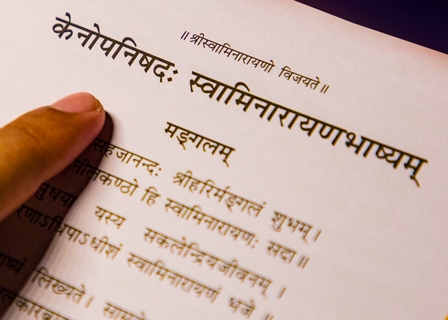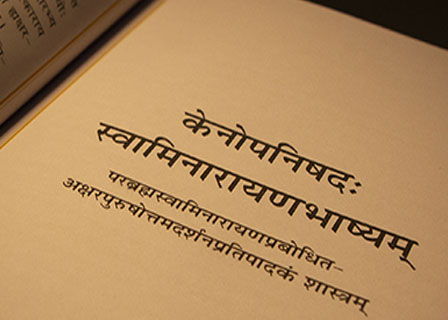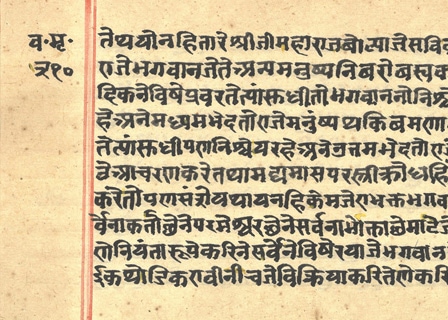The Rewards of Commentary
Lucidity
The commentarial tradition introduces significant features towards the systematization, expansion, and preservation of Indian thought. For instance, their seminal role in providing detailed expositions encompasses specifying (1) a natural reading (the anvaya) of the base text, (2) the reference or synonyms of the terms of the primary text, (3) the sense in which these terms are employed, (4) rationalization(s) or justification(s) for the semantic offered, and (5) the implications or significance of this semantic. These elaborations clarify ambiguities, ensure a comprehensive reading of the principal meaning of the text, and identify its implications and significance to provide an informed reading of the primary text.
Hermeneutical Structures
In addition to providing informed readings, commentaries also express hermeneutically-driven structures of the base text. The tātparyanirṇaya—“उपक्रमोपसंहारोऽभ्यासोऽपूर्वताफलम्। अर्थवादोपपत्ती च लिंगं तात्पर्यनिर्णये॥”—for instance, not only identifies a means for distilling the purport of a text (or its chapters and sections), but also presumes the commented work to be structured accordingly. Commentaries also presume additional organizational elements of the base text. For example, bhāṣyas on Vyas’ Brahmasūtras specify sections (adhikaraṇa) by identifying sūtra(s) in the Brahmasūtras that express a specific viṣaya (subject), saṃśaya (doubt), pūrvapakṣa (prima facie viewpoint), uttarapakṣa (response), siddhānta (conclusion), and saṅgati (coherence). Saṅgati (coherence) is further elaborated by specifying śāstra-saṅgati (consistency or flow of discussion within the text in its entirety), adhyāya-saṅgati (consistency or flow of discussion within a chapter), and pāda-saṅgati (consistency or flow of adhikaraṇas within a section). In addition to these three types of saṅgati, there is a presumed relation among the adhikaraṇas or sections themselves. One adhikaraṇa (sub-section) leads to another through some association of ideas. In a pāda (section) there are many adhikaraṇas (subsections) that are combined by a well-reasoned structure. The saṅgati which binds one adhikaraṇa with another is further categorized as being six kinds: (1) ākṣepa-saṅgati or objection, (2) dṛṣṭānta-saṅgati or illustration, (3) prati-dṛṣṭānta-saṅgati or counter-illustration, (4) prasaṅga-saṅgati or incidental illustration, (5) utpatti-saṅgati or introduction, and (6) apavāda-saṅgati or exception. Commentarial elaborations on each of these elements express not only text-specific hermeneutical principles but also a specific hermeneutical structure to the base text they elaborate upon.
Accessibility
By presenting these expositions, a commentary also increases the accessibility of its base text. Its detailing of individual terms, elaboration of presumed descriptions or argumentations, and elucidation of contextual elements that effect meaning allow for a broad range of readership to comprehend and appreciate nuances found within the commented work. In turn, these clarifications mitigate language, cultural, regional, disciplinary, and temporal barriers that would otherwise limit the reception of the text.
Significance and Preservation
Through their extensive expositions, commentaries also reveal the depth and significance of the revelations found within the base text. By highlighting the unique insights and features afforded by these texts, commentaries implicitly emphasize the gravity of the work it analyzes. This often resulted in not only the prominence of the commentary itself but also the preservation of the base text. The effect of such mutual endorsement is often witnessed throughout all disciplines of Indian thought where revelations of a commented text are safeguarded by committing them to even memory, allowing for a work to sustain in the absence of a text. Related to this phenomenon, the creation of commentaries also allowed for principles to be consolidated into short, terse revelations. Without the possibility of commentaries to elucidate the meaning of succinct revelations, much of sūtra literature would not exist as it does, since concise revelations would remain ambiguous or inaccessible.
Audience-Specific Expositions
The commentarial tradition also allowed for commentaries to be tailored to specific target audiences. Some commentaries like Annambhaṭṭa’s Dipika serve as introductory works by providing expositions that requisite little familiarity with the positions of Navya-nyāya; whereas other texts like Bhaṭṭojidīkṣita’s Prauḍhamanoramā demand considerable proficiency in discipline-specific terminology, the content of its base text, and a working knowledge of its application. The nature or requisites for the study of these works are typically indicated within the specification of the adhikārin in the text’s anubandhacatuṣṭaya: “विषयश्चाधिकारी च सम्बन्धश्च प्रोयजनम्। अनुबन्धं विना ग्रन्थे मङ्गलं नैव शस्यते॥” In addition to accommodating the diverse proficiency of its readership, these graduated commentaries formed an unformalized curriculum of sorts, allowing those unfamiliar of the subject to gradually acquire expertise.
Grounding and Guiding Reflection
The textual composition of the commentary also features a location or context for elaborations and discussions. Grounding such reflections in revelations from a base text affords authority, context, and relevance to the elaborations that are provided. Consequentially, such location-specific reflection provides an address to the deliberation of arguments advocating the position of the commentator, the consideration of opposing viewpoints, and responses to these oppositions. Consolidating these dialogues in one elaboration contextualizes the discussions undertaken. This contextuality also ensures that the creative aspects of commentarial exposition are not capricious or arbitrary but relevant to the revelation of the base text and considerate of the positions and expositions advocated throughout both the commentary and the commented text.
A Venue for Inter-Disciplinary Reflection
Additionally, commentarial elucidations of a specific reading allow for interdisciplinary reflection—discussions that consist of, for instance, grammatical, literary, hermeneutical, or philosophical reflections. Combining discipline-specific reflection under one exposition not only attests to the multi-disciplinary proficiency of the author but also is a testament to the integrated nature of the various fields of study within Indian thought.
A Source for Critical Editions
Another feature distinct to commentarial works is its inclusion or discussion of alternative renderings of the base text. By recalling various versions of the text and occasionally even evaluating their credibility, commentaries serve as rudimentary critical editions.
Citation and Substantiation
Substantiating reflections within a foundational text also allows commentaries to add to preceding elaborations. As a result of their supportive nature, commentaries served primarily as sources of constructive creations—a much more daunting task than that employed by other destructive enterprises. This is not to say that commentaries did not oppose other points of view; they did and to a great extent. However, their primary objective was not to deconstruct, but rather to elaborate, substantiate, and build upon existing frameworks. Such focused reflection afforded commentaries to conduct closer investigations and analysis. This adherence also guided new contributions to be directed towards a common end. As commentaries themselves were commented upon, discussion contained within subsequent expositions became increasingly in-depth and nuanced, allowing for more precise analysis and the establishment of more robust positions.
Development of Independent Schools of Thought
This direction led to the development of various organized schools of thought. As positions solidified through a lineage of commentaries and sub-commentaries, they formed distinct identities, each established on a set of foundational principles rooted in commentarial differences. The Pūrvamīmāṃsā schools of Kumārila Bhaṭṭa and Prabhākara serve as prime examples of such identity creation, since both schools originated from distinct commentarial reflections on a common set of revelations. Similarly, within the Vedanta Darśana, Advaita, Viśiṣṭādvaita, Dvaita, Dvaitadvaita, Śuddhādvaita, Acintyabhedābheda, and most recently, the Akṣara-Puruṣottama Darśana—all comprehensive systems of thought—obtained distinct identities as independent Vedānta darśanas from their unique commentarial readings of the Prasthānatrayī—a common corpus of texts consisting of the Upaniṣads, Bhagavadgītā, and the Brahmasūtras. Throughout Indian history, the continued creation of such commentaries and their subsequent schools of thought is a testament to the living and forever changing landscape of the commentarial tradition and the immense creative enterprise contained therein.
The Svāminārāyaṇabhāṣya — A Testament to the Living Commentarial Tradition
Inspired and blessed by His Holiness Pramukh Swami Maharaj, the Svāminārāyaṇabhāṣya is a recent addition to this commentarial tradition. As a collection of the following five volumes: the Īśādyaṣṭopaniṣat-Svāminārāyaṇabhāṣya, Chāndogyopaniṣad-Svāminārāyaṇabhāṣya, Bṛhadāraṇyakopaniṣad-Svāminārāyaṇabhāṣya, Śrīmadbhagavadgītā-Svāminārāyaṇabhāṣya, and the Brahmasūtra-Svāminārāyaṇabhāṣya, the Svāminārāyaṇabhāṣya is a comprehensive commentary of the Prasthānatrayī—the principal ten Upaniṣads, the Bhagavadgītā, and the Brahmasūtras—according to the principles of the Akṣara-Puruṣottama Darśana revealed by Parabrahman Puruṣottama Bhagavān Svāminārāyaṇa. By establishing an independent Vedānta darśanic school: the Akṣara-Puruṣottama Darśana, the bhāṣya is comparable in significance to the other Vedānta commentaries. Advantaged with the many millennia of reflection that preceded it, it is uniquely positioned to benefit from the methodological developments, intellectual depth, and discerning wisdom of the eminent works of the Indian commentarial tradition. Although this tradition is historically founded, the creation of the Svāminārāyaṇabhāṣya is a testament to its endearing capacity to provide foundational and innovative discoveries, while maintaining the values and principles that are at its core.





